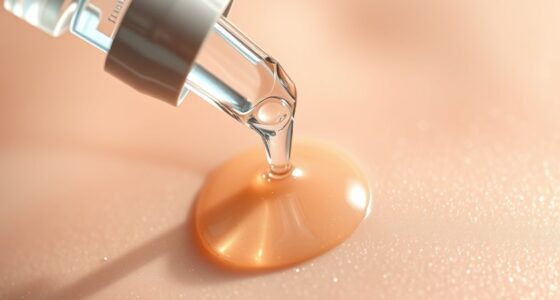Tinted sunscreens combine mineral UV blockers, like zinc oxide or titanium dioxide, with skin-toned pigments to offer both sun protection and an even, natural look. The pigments sit on your skin’s surface, reflecting or scattering harmful rays, while the minerals form a physical barrier. Adjusting pigment types and amounts guarantees a seamless blend with your skin but still provides effective defense. Keep exploring to uncover more about how these innovative formulations work together to protect and beautify your skin.
Key Takeaways
- Tinted sunscreens combine mineral pigments with sun-blocking ingredients to provide both UV protection and a natural skin tone.
- Pigments reflect and scatter UV rays, forming a physical barrier that enhances overall sun protection.
- The formulation ensures pigments blend seamlessly with skin while maintaining the efficacy of UV filters.
- Stability of pigments prevents degradation, ensuring consistent, long-lasting protection throughout the day.
- They offer dual defense and aesthetic benefits by combining chemical and physical UV protection with skin-tone matching.

Tinted sunscreens have become a popular choice for those seeking both sun protection and a hint of coverage. You might appreciate how they seamlessly blend skincare and makeup, offering a convenient solution for daily wear. At their core, tinted sunscreens work by combining traditional sun-blocking ingredients with pigments that provide a natural-looking tint. These pigments are carefully formulated to guarantee they don’t compromise UV protection, which remains their primary function. The pigment formulation in tinted sunscreens isn’t just about aesthetics; it plays a vital role in how effectively the product shields your skin.
The key to their effectiveness lies in the way the pigments interact with UV rays. These tiny particles, often mineral-based like titanium dioxide or zinc oxide, sit on the surface of your skin and reflect or scatter harmful UV radiation. Unlike traditional clear sunscreens, the pigments in tinted versions add a layer of physical protection that enhances coverage. This means your skin gets a dual defense: chemical ingredients absorb UV rays, and pigments deflect them away. This combination can improve overall UV protection, making tinted sunscreens a reliable choice even during intense sun exposure.
The pigment formulation is carefully designed to provide a natural tint that matches a wide range of skin tones. Manufacturers select specific mineral particles that not only protect but also blend smoothly with your complexion. The goal is to offer enough coverage to even out skin tone without looking heavy or unnatural. This balance is achieved by adjusting the size, concentration, and type of pigments used. When applied, tinted sunscreens create a subtle, uniform color that helps conceal minor imperfections while maintaining the product’s protective qualities.
Another advantage of the pigment formulation is its stability. Properly formulated tinted sunscreens resist oxidation and degradation over time, ensuring consistent UV protection. The pigments also help stabilize active ingredients, preventing them from breaking down when exposed to sunlight. As a result, your skin benefits from sustained protection throughout the day. You’ll find that the formulation’s effectiveness depends on the quality of the pigments and their distribution within the product. Well-made tinted sunscreens will not only shield you from UV rays but also provide a pleasing, natural finish that enhances your skin’s appearance.
Frequently Asked Questions
Do Tinted Sunscreens Protect Against Blue Light and Digital Screens?
Yes, tinted sunscreens can provide blue light protection and digital device shielding. Their pigments help block some blue light emitted from screens, reducing eye strain and potential damage. When choosing a tinted sunscreen, look for formulations specifically designed for blue light protection. Keep in mind, though, they might not block all blue light, so consider additional digital eye care practices for extensive shielding during prolonged screen time.
How Long Do Tinted Sunscreens Last on the Skin?
Tinted sunscreens typically last about two hours on your skin before you need to reapply. The application duration can vary based on your skin type, activity level, and exposure to water or sweat. To maintain protection, it’s best to reapply every two hours, especially when outdoors or after swimming. Always follow the instructions on the label for maximum effectiveness and guarantee continuous protection against UV rays.
Can Tinted Sunscreens Replace Regular Sunscreen?
You shouldn’t rely solely on tinted sunscreens to replace regular sunscreen. Tinted options mainly offer mineral filtration and a chemical barrier, which may not provide enough broad-spectrum protection. Regular sunscreens are formulated to safeguard your skin from UV rays all-encompassing. For best results, combine tinted sunscreens with regular ones, ensuring you get the mineral filtration and chemical barrier protection you need, while enjoying the added benefits of tint.
Are Tinted Sunscreens Suitable for All Skin Types?
Yes, tinted sunscreens are suitable for most skin types, but your skin tone and sensitivity matter. If you have fair skin or sensitive skin, choose a tinted sunscreen formulated for your specific needs to avoid irritation or uneven coverage. Tinted sunscreens can blend seamlessly with your skin tone and provide added protection, but always check the ingredients and do a patch test first to guarantee they work well for your skin.
Do Tinted Sunscreens Stain Clothing or Fabrics?
Think of tinted sunscreens as a gentle shield—not a stain in disguise. They can sometimes cause clothing staining or fabric compatibility issues, especially with lighter or delicate fabrics. To avoid this, let the sunscreen fully absorb before dressing and opt for fabrics less prone to staining. While not everyone experiences issues, being mindful helps keep your clothes spotless and protected from potential stains.
Conclusion
Now that you understand how tinted sunscreens work, aren’t you curious about how they can better protect your skin while enhancing your look? By blocking UV rays and reducing visible light, they offer more than just coverage—they provide smarter defense. So, next time you choose sunscreen, ask yourself: isn’t it time to combine style with science for superior skin protection? With tinted options, you don’t have to compromise on beauty or safety.









